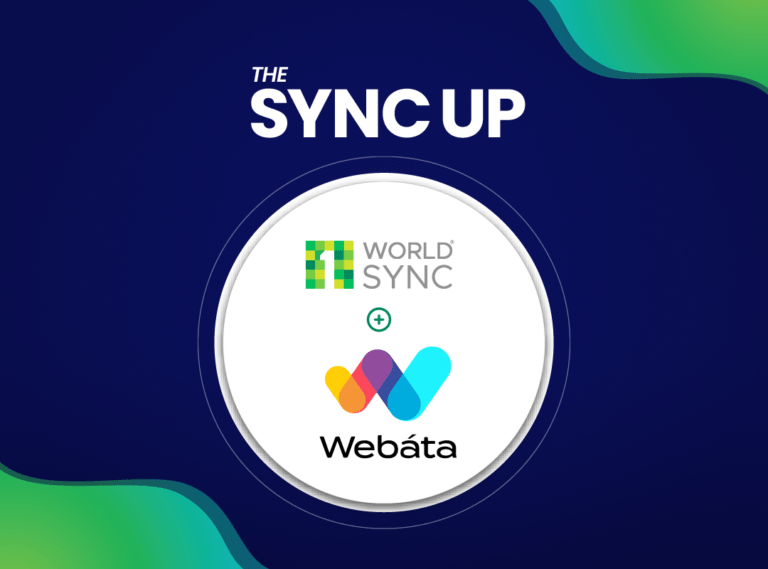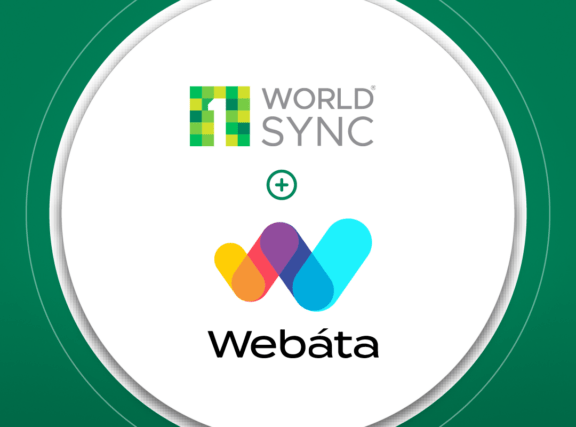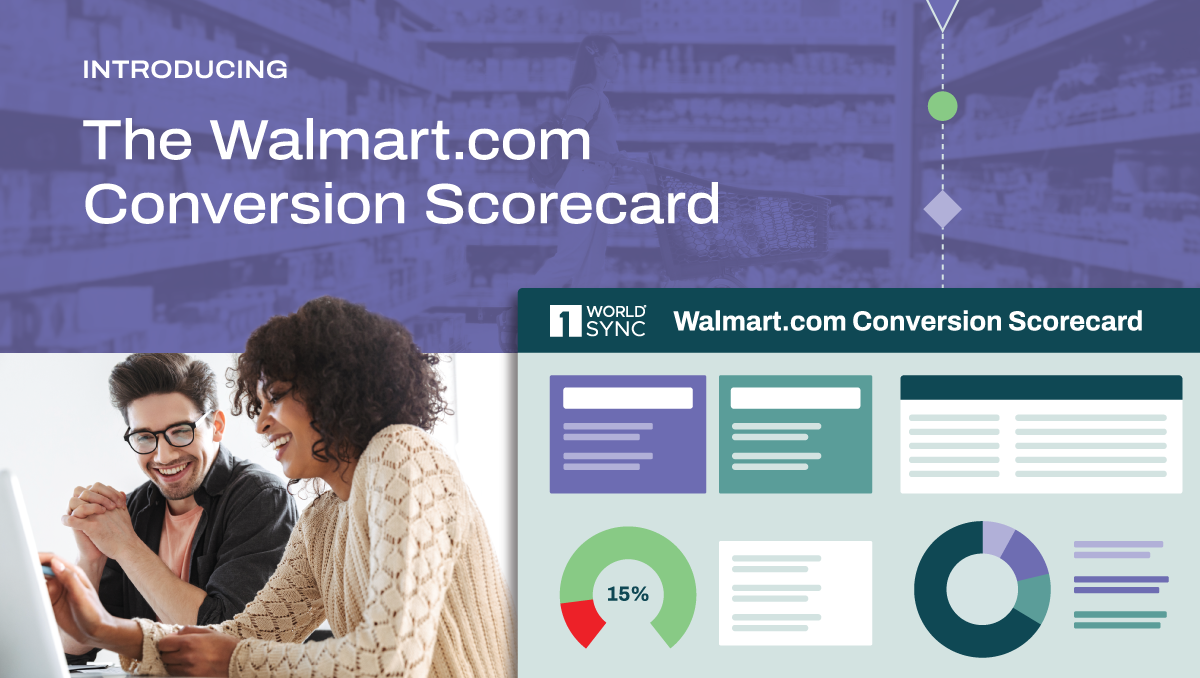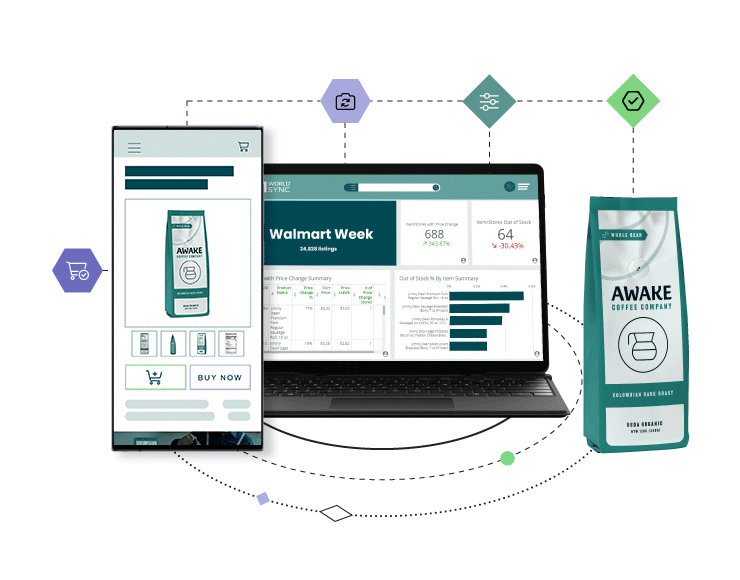The Sync Up: E-Commerce Analytics with Webata’s Gabe Wight
March 15, 2023

Last week 1WorldSync acquired the retail e-commerce analytics technology firm, Webata. The exciting addition to our product content platform will help our brand customers identify their “next best action” in areas critical to sales growth at retail e-commerce shops like Walmart.
Webata customers receive a powerful suite of services and reporting, including SEO keyword winnability, store-level pricing analysis, content quality measurements and real-time out-of-stock (OOS) insights.
Randy Mercer, Chief Product Officer, sat down with Webata’s co-founder, Gabe Wight, to learn more about the platform and to welcome him to the 1WorldSync family. They discuss the unique challenge brands face when selling online at traditional brick and mortar retailers, key use cases of their technology for both small and enterprise brands, and how hybrid shopping is forcing brands to think differently about their online sales.
Listen to their conversation in this special Sync Up podcast below (9-minute listen) or read the entire interview transcript. And stay tuned for more opportunities to learn about Webata via upcoming 1WorldSync webinars.
Podcast: Why Retail E-Commerce Analytics is Critical in the Hybrid Shopping Era
1WorldSync Improves Analytics Capabilities with Acquisition of Webata
Randy Mercer: Hi, everybody. My name is Randy Mercer, with 1WorldSync and I run the product organization for us. Part of my job is to make sure that our platform continues to evolve in the direction that’s most going to help our customers, both on the brand side and the retail side. So no surprises here, but one of the things that we’ve noticed over the last few years is the continued emergence of the hybrid shopping experience where customers are doing some of their shopping online, some of it in the store and then a lot of research before they go into the store.
One of the things that we’ve really worked to strengthen as part of our portfolio is analytics that we could be providing our customers to help them improve how they’re performing online and understand what actions they could be taking to improve that. So, with that in mind, I’m really excited to introduce the newest addition to our portfolio, a retail e-commerce analytics platform aimed at helping our customers in the way that I just described. I would like to introduce the co-founder of that solution: Gabe Wight.
Gabe Wight: Hi Randy, great to be sitting here with you.

The Emergence of Grocery in E-Commerce Fragmented Traditional Analytics
Randy: So just tell me a little bit about Webata, and in your experience, having been around the retail and e-commerce space for a long time, what things were you seeing that led you to believe that you could create a solution for some of the problems folks would have?
Gabe Wight: I think the emergence of grocery in e-commerce was a big turning point where all of a sudden we were starting to do curbside, pick-up and delivery as consumers. We’re starting to get groceries delivered straight to our house from the store, so not everything is shipping in from one central warehouse. Now, all of a sudden, e-commerce is being fulfilled from the store. It really just opened up a whole new world of dynamic e-commerce.
With traditional e-commerce you’d buy from, maybe an Alibaba or an Amazon, and there’s a warehouse that fulfills it and if that warehouse doesn’t have it, it doesn’t really matter, because I can ship it from a different warehouse and all ships to your house. If you can’t ship lettuce, for example, or if it’s more difficult to ship lettuce from this warehouse or that warehouse, the product needs to be in the store. So effectively this is a big fragmentation of websites.
So a retailer, like a Walmart, has 4,600 stores and effectively has 4,600 plus websites. And so e-commerce became a much more difficult thing to understand. With an Amazon, you’re either in stock or you’re not. It’s a binary. But with Walmart, if you want to know, “Is my item in stock at a Walmart for e-comm?” it’s really 4,600 plus answers. So that ability to manage and understand the business, it just looked like open space [for us]. Webata was asking questions like: How do we grow our clients’ business? And the answers just weren’t there.
Why is Retail E-Commerce Analytics Important for SMB Brands and Enterprise Brands Alike?
Randy: So with the smaller brand in mind where maybe you’ve got a limited resource, maybe you have one person that’s trying to chase down content and manage online sales and track down pricing and all of that. How do you help that? And how do you help that brand?
Gabe: I can think of a couple of very specific examples, one of which is we’ve got a client who has 4 SKUs. They do well with those four SKUs and fought hard to get a fifth SKU in, but there are some pretty tight velocity constraints of keeping that SKU in.
And so we started looking at the data and something wasn’t right. They just weren’t selling what we all thought they should. Come to find out within just a couple of weeks, we discover that the SKU had not been published online, and so no shopper at any of those stores ever saw that SKU. It just didn’t have an item page at those stores, and so getting that SKU turned on turned out to be the difference in velocity to keeping that SKU in store. If you’re a small brand going from four SKUs to 5, that’s a big deal.
Randy: So now look at the polar opposite of that. Tell me about the big brand that maybe has hundreds of SKUs online, in-store, combination thereof . . .
Gabe: We work with a lot of brands that have in some cases thousands of SKUs. In that case, it’s hard to know: What do I look at? And I’ll give an example. It’s just maybe 3 or 4 weeks ago we were sent an alert out that a client has an under-three-dollar body wash listed at $10.20 cents. I don’t know about you, but most people, if you’re shopping for an under-three-dollar body wash you’re probably not spending $10.20. Anecdotally, the information goes back to us that this alert may have saved them $400,000 to $500,000 in sales, just because of those body washes at those hundreds of stores.
But unless you’re actively going to every store location online, looking at all your items, you just don’t see those. And so our ability to alert to these issues becomes a much easier way to know where to focus and what to take care of next to move on with the day.
Understanding the Sales Potential of Online in Hybrid Shopping Era
Randy: So one of the things that we help our customers with is producing content and orchestrating the delivery of that content in such a way that it really provides a much improved online experience. So when you think of the hybrid shopping experience, especially in the CPG space, the emergence of maybe starting online, and then ultimately going into the store. How does Webata help our customers with that experience?
Gabe: I think personally, one of the things that we do is we help understand what the sales potential of online is. So many CPG customers or brands still don’t have great visibility into traditional brick and mortar retailers like Walmart or Target. They’ll ask, “Is online really important?”
They maybe are looking at the ship-to-home numbers, and see that it’s only a couple of percent of sales. But then, when you look at the curbside pickup delivery all of a sudden, now you’re in that 15% of sales, 20% of sales, the 25% of sales. That’s just what’s being transacted online.
Now, the other piece of that is the degree to which we see a correlation with online presence and in-store sales. When you have a great online presentation, a customer can go and build their list online. Maybe they’re still going to the store to fulfill that list, but they build that list online and they’re discovering online.
A lot of times we think about that for only the higher ticket items like electronics – but it isn’t. That’s how customers are shopping today. They’re building the list of the week using online. They’re searching online. I need a kid’s cereal, whatever the case may be, and I’m going in-store and fulfilling that list. So it’s become I think, an integrated way that we all live today online. Whether or not we fulfill online, which is a significant part of sales, or whether we fulfill in-store, we’re seeing the promise of the omni-shopper finally come around.
1WorldSync + Webata: What does it mean for customers?
Randy: So now I’ll just look across the 1WorldSync customer base; our primary or core competency is helping orchestrate the process of sharing content. From the brand: Where does it come from? How do you get it out to the marketplace to actually represent your brand? And on the retailer side, we help them efficiently acquire everything they need to run their business. So when thinking about all of that, what is Webata’s value proposition relative to how our customers currently use 1WorldSync?
Gabe: So I think 1WorldSync does such an amazing job and has such a great legacy in how a product represents itself online. From static content to seasonality, there’s a lot of things 1WorldSync facilitates and does so in a really wonderful way. You help make clear: what is that product content? How does one present themselves online from a product perspective? Where Webata comes alongside is: How is that all performing?
And so we think about a few key areas. We think about number one: Keywords and rankings, including organic rankings, sponsored rankings — all the keywords for which an item ranks. Is an item ranking for more keywords or fewer than it did? How do we improve that SEO? And then how do we understand what the competitors are sponsoring and leverage that as a brand as a competitive advantage?
We also think about that store-level information we talked about with pricing and stock, those sorts of metrics. And then we also think about how that all relates back to sales. Does it have an impact on the bottom line, which is a critical piece. So I’d say in one word, it’s the performance piece of how the items are doing online.
Randy: For everybody listening, I just want to say again how excited we are to add Gabe and his team and the Webata solution to the 1WorldSync solution portfolio. We just know it’s going to add a ton of value to what we’re already helping our customers with and help everyone get more value out of what we’re doing all the way from content creation to delivery. And now, really understanding how you can optimize that. So beyond what we’ve talked about today, be on the lookout for upcoming webinars that are going to tell you a lot more about the solution, and how it places into the rest of the things that we do, and how everybody can take advantage of it.
Gabe: Thank you, Randy.




